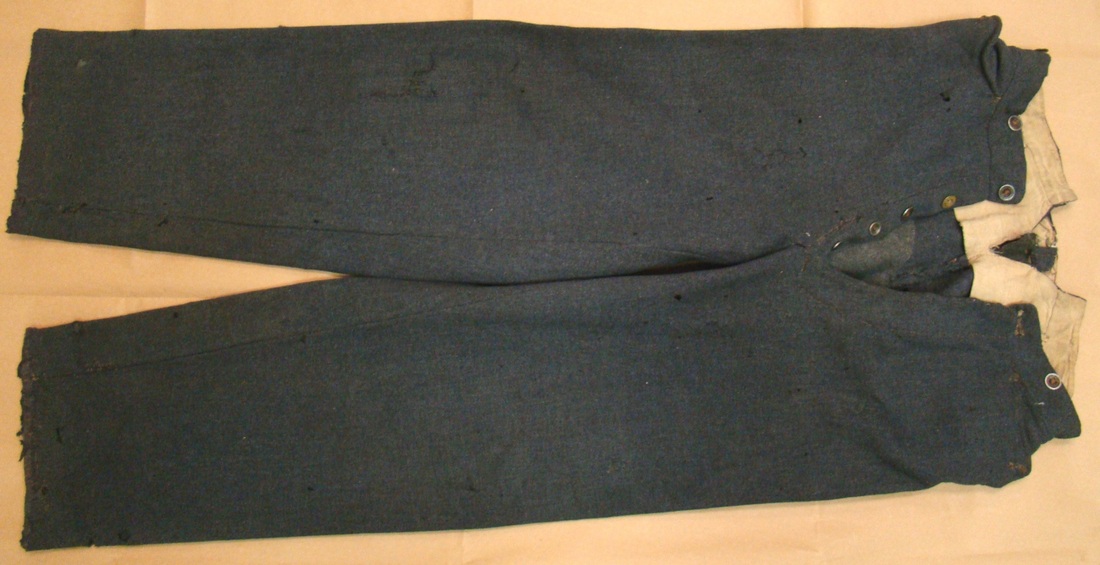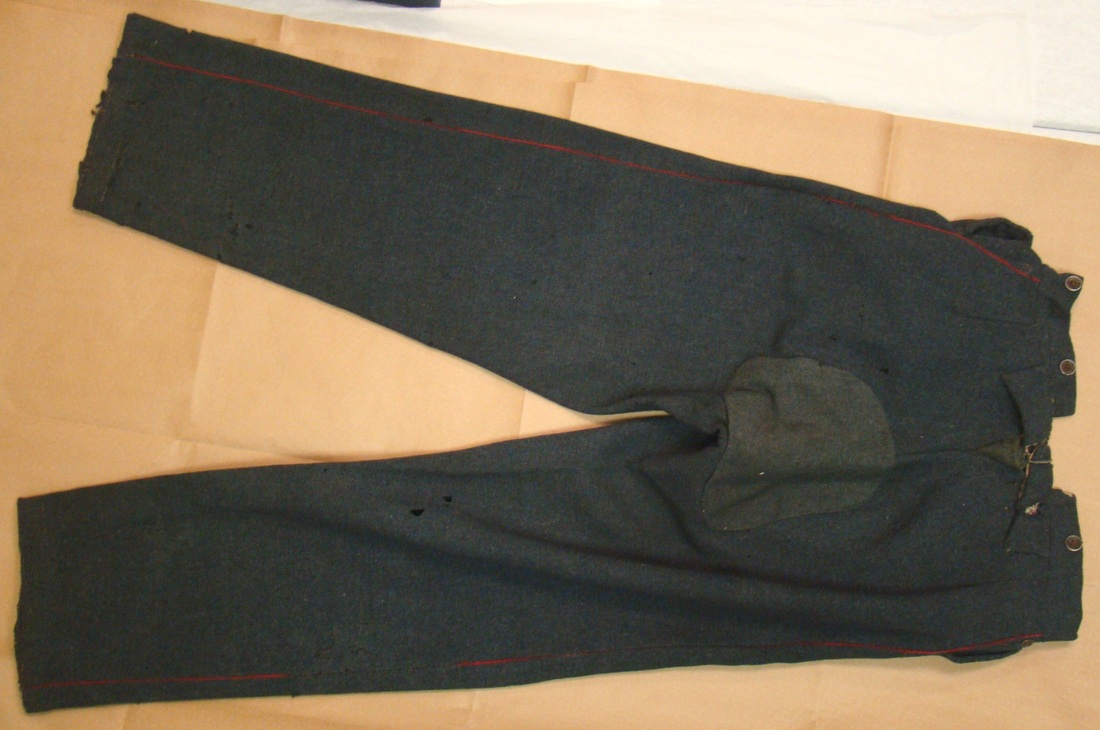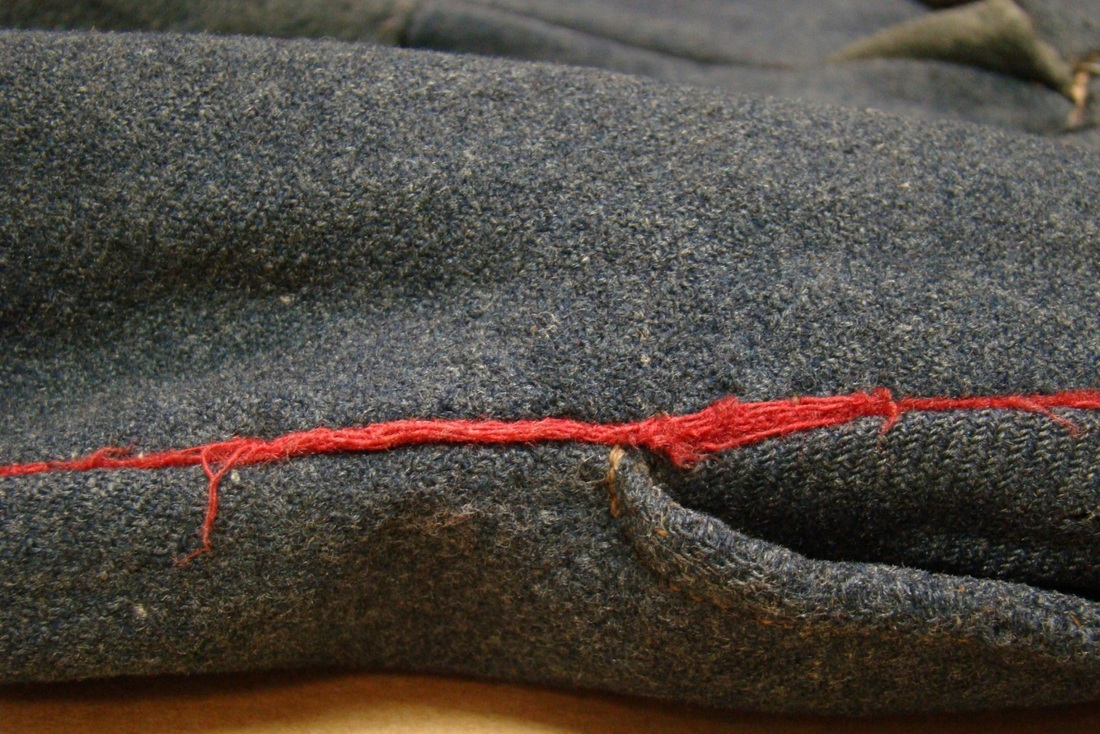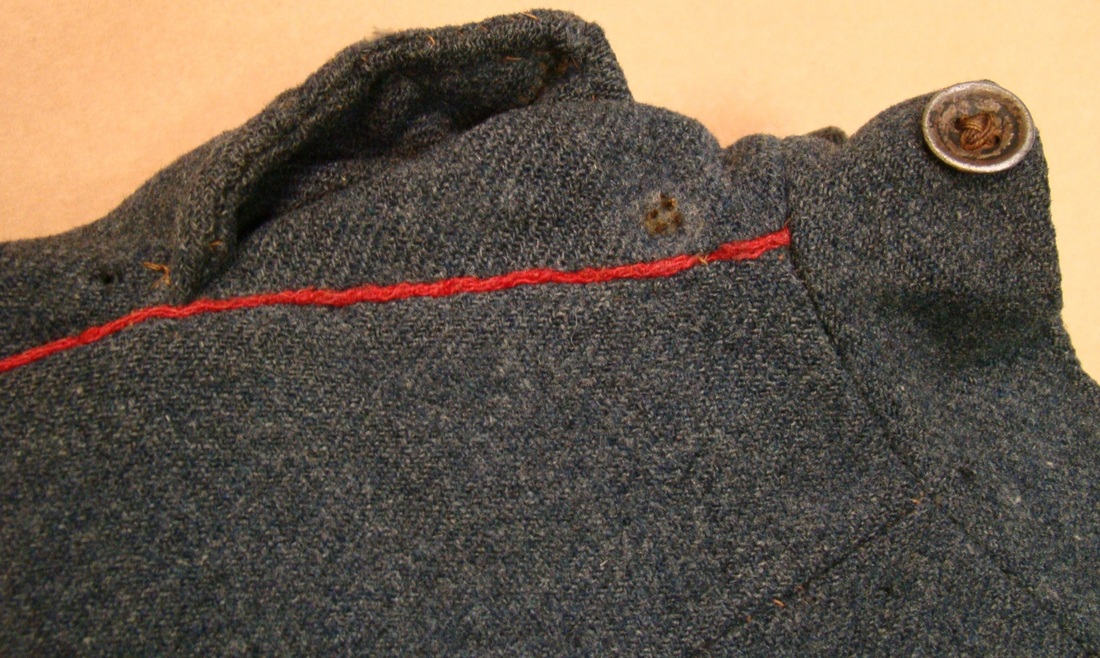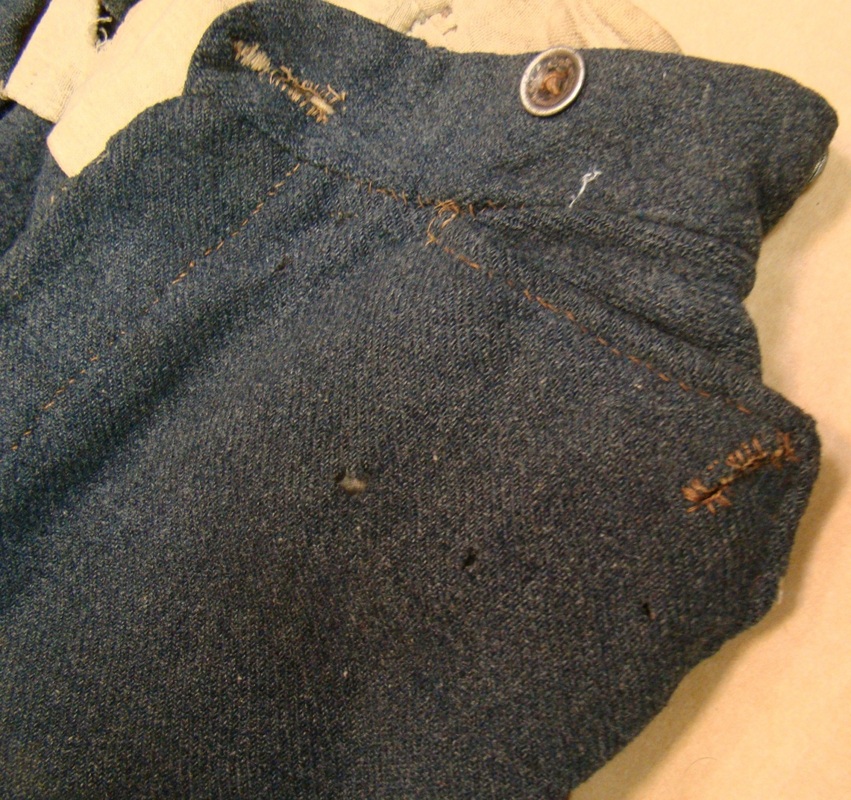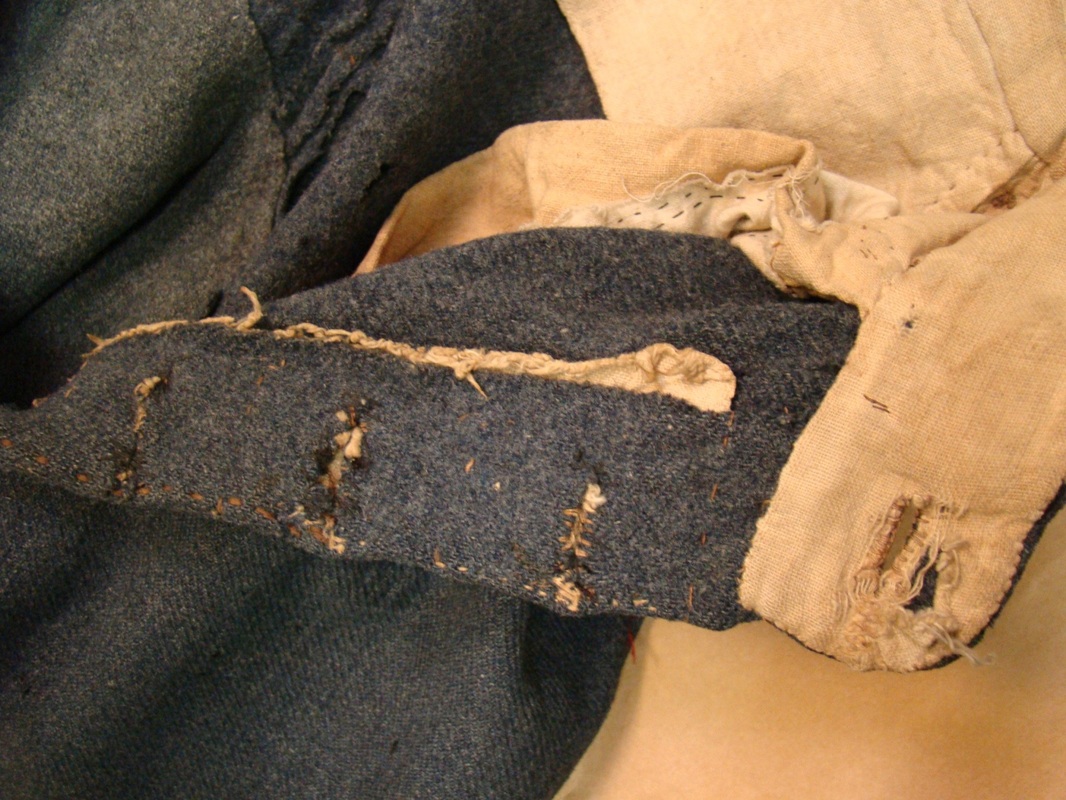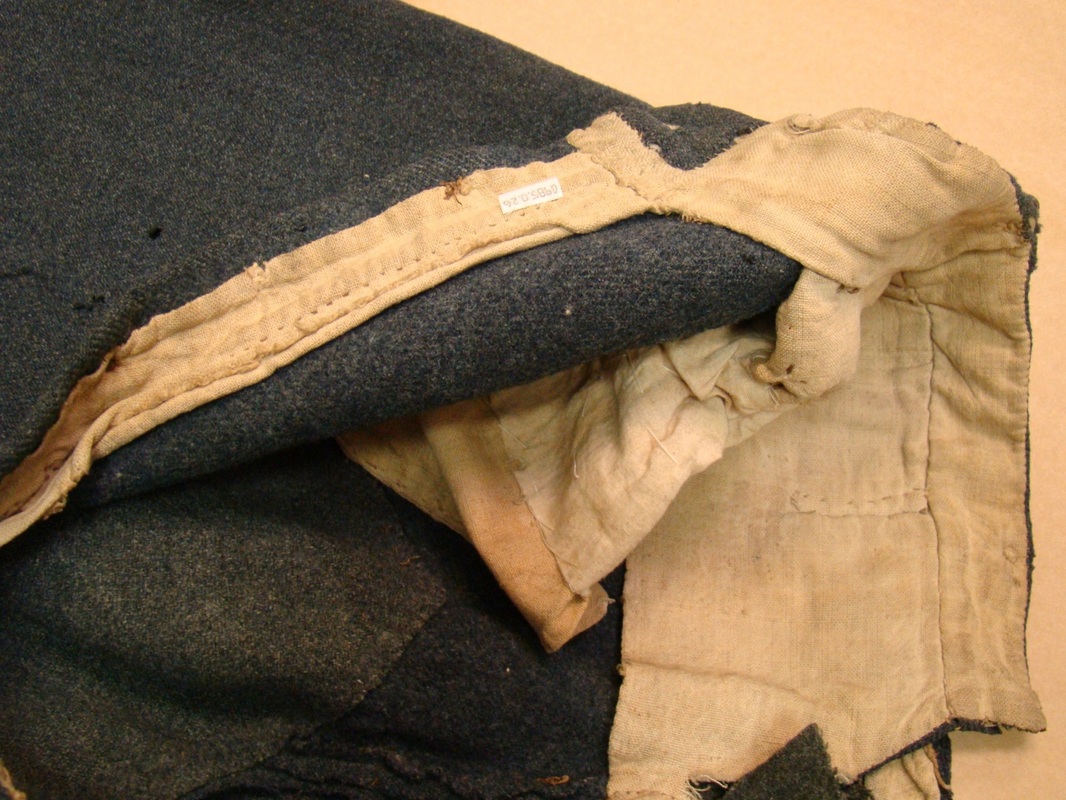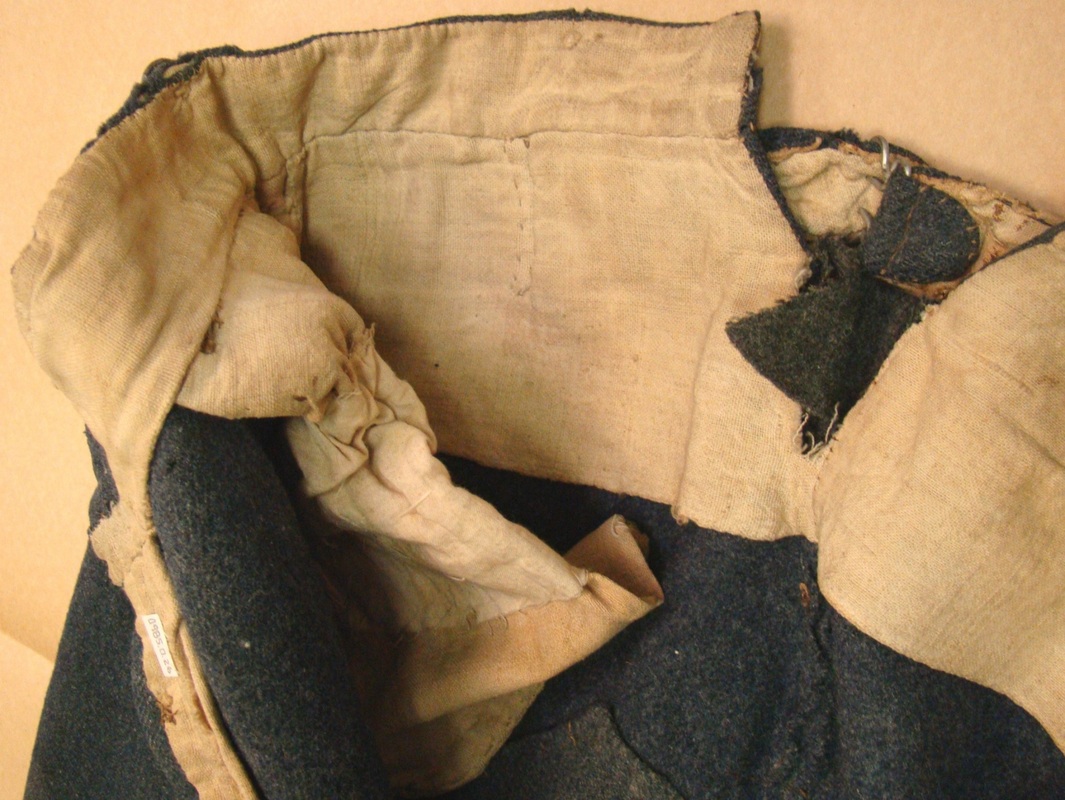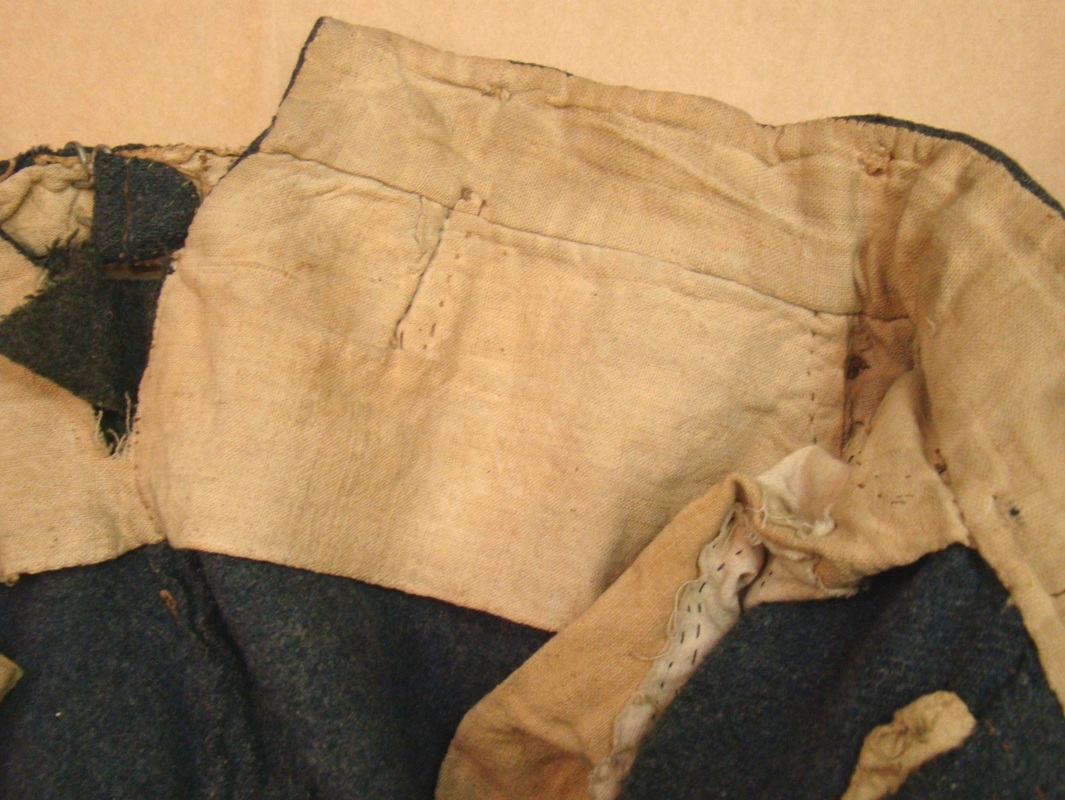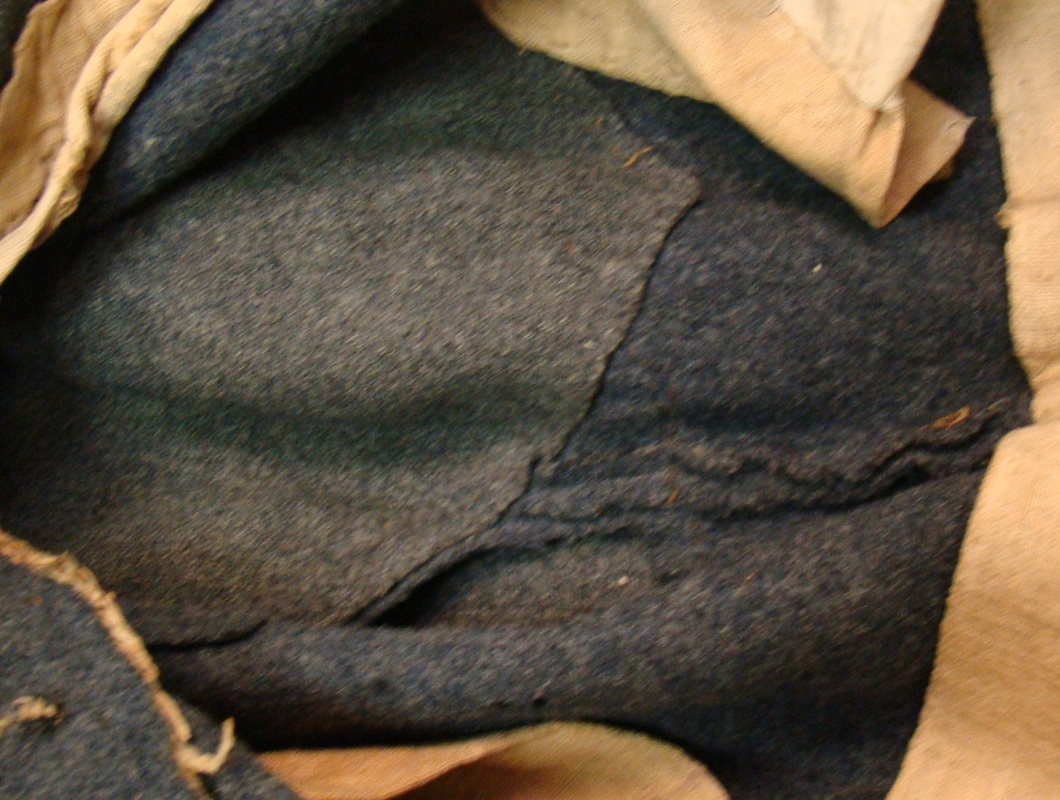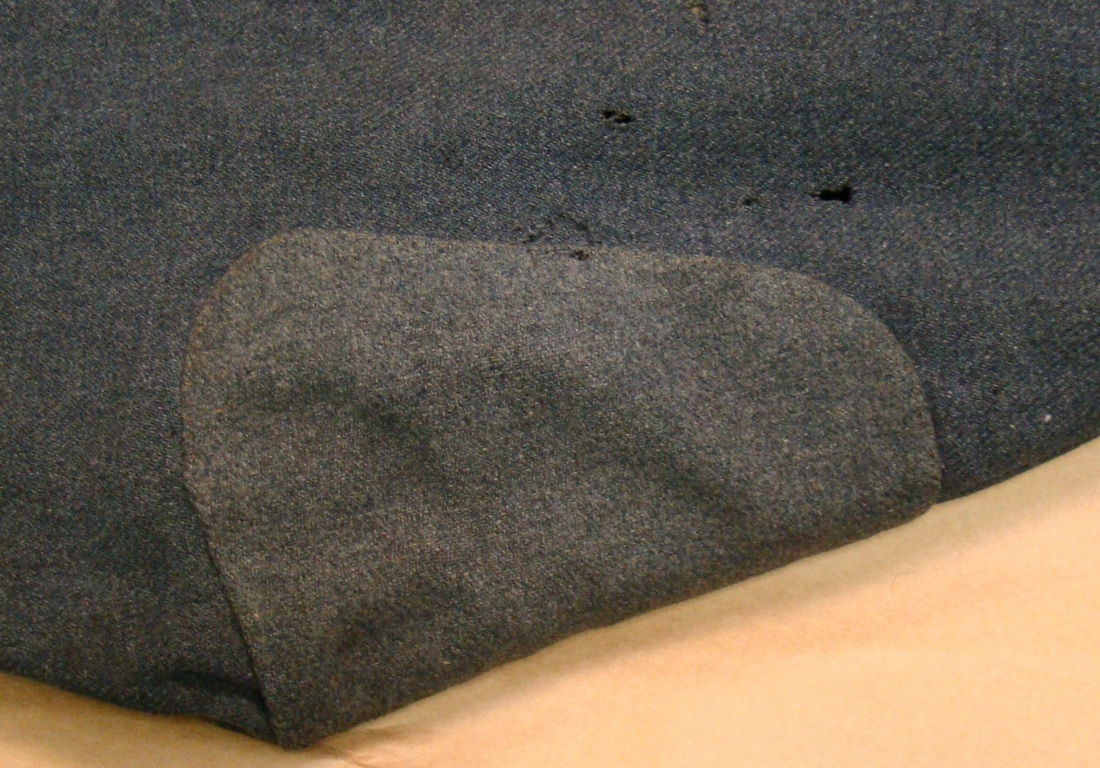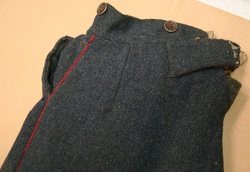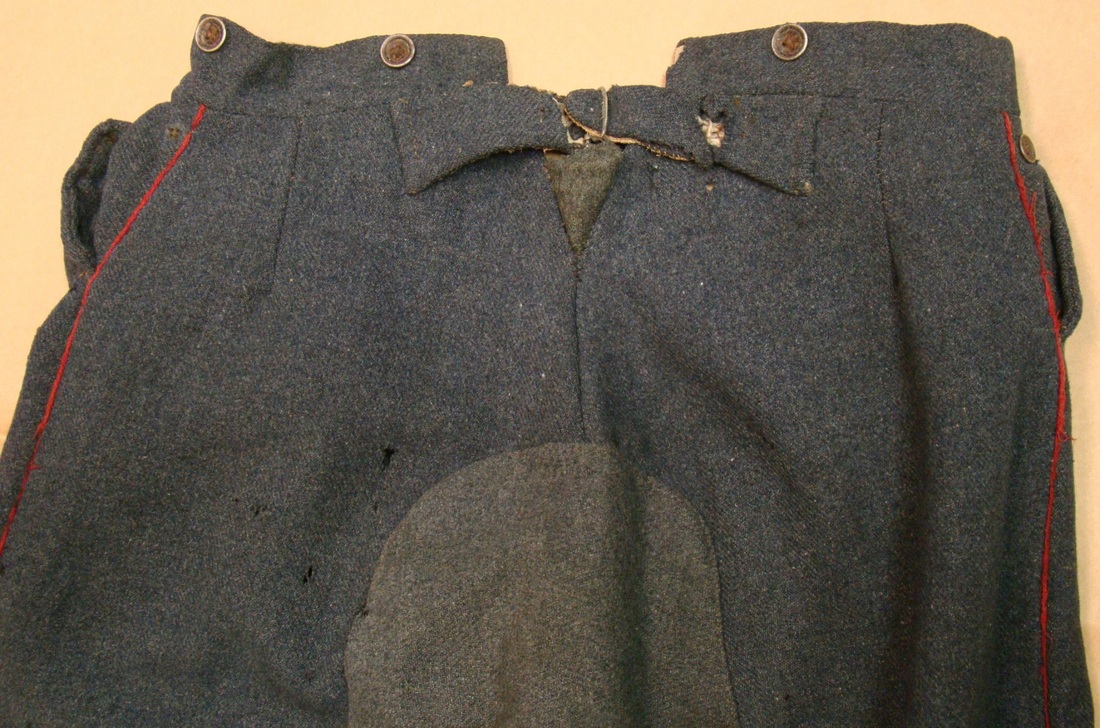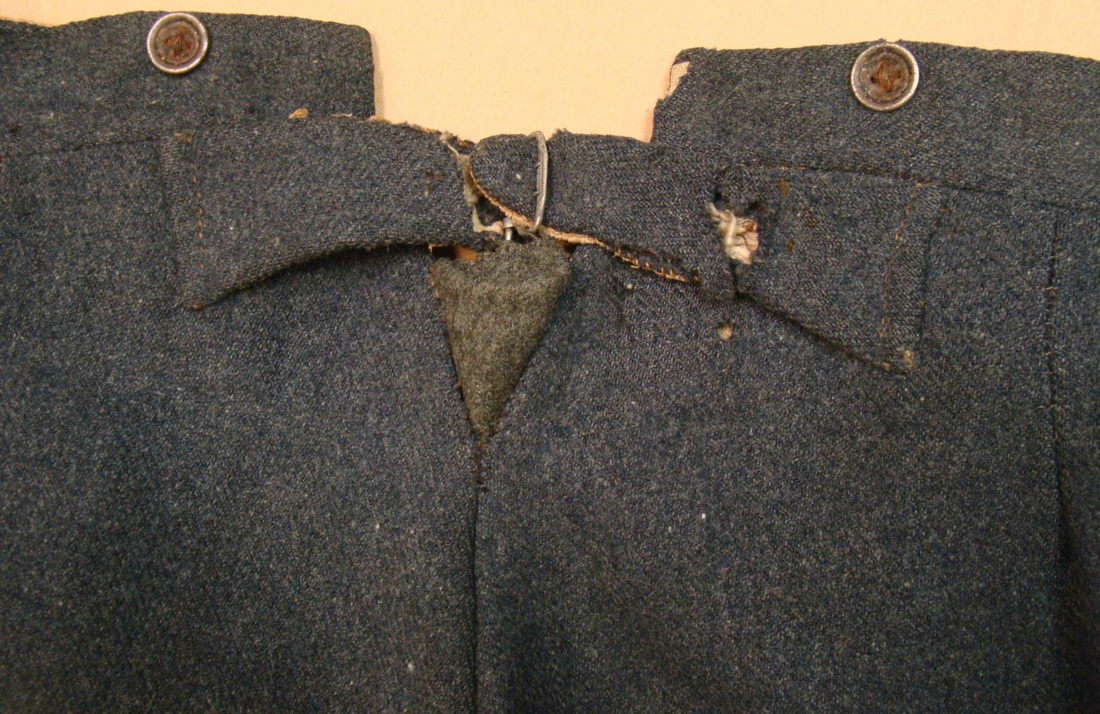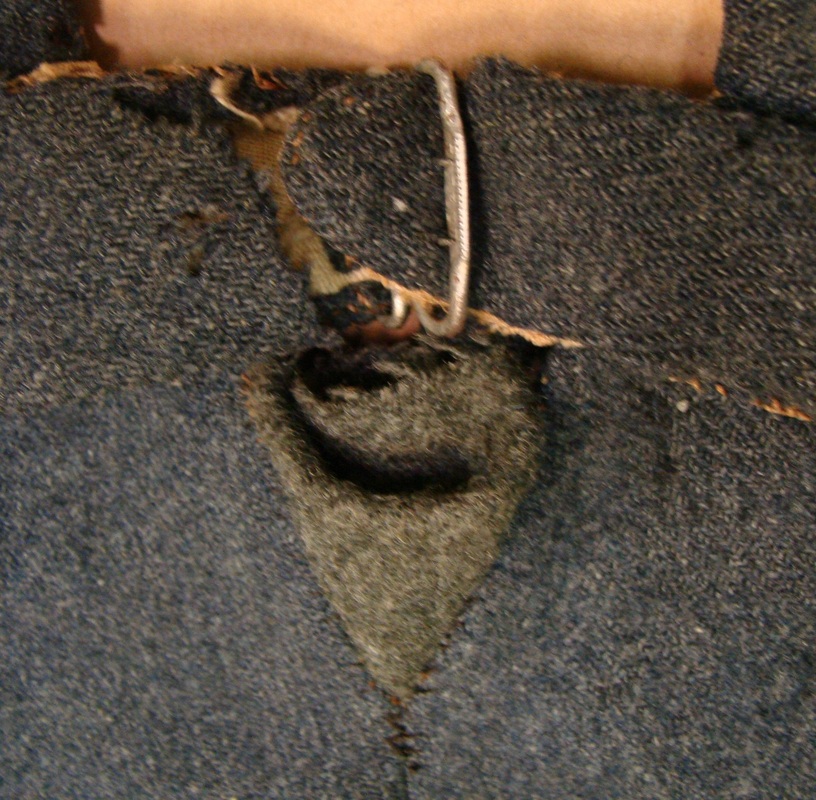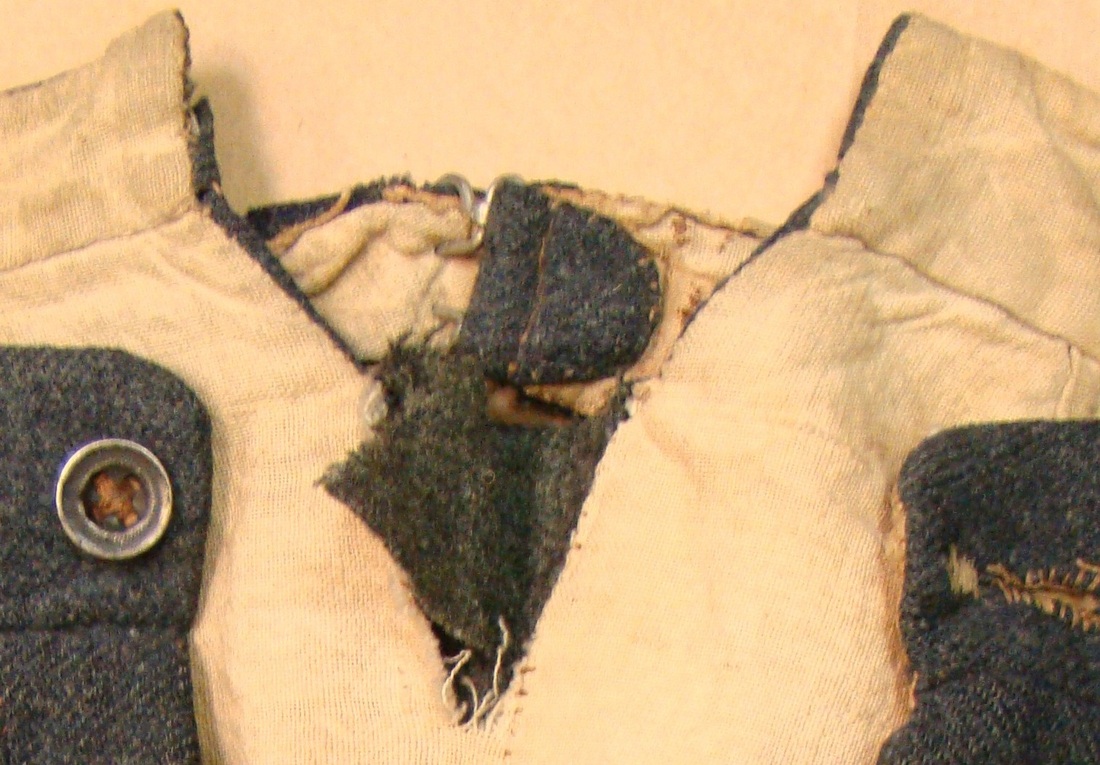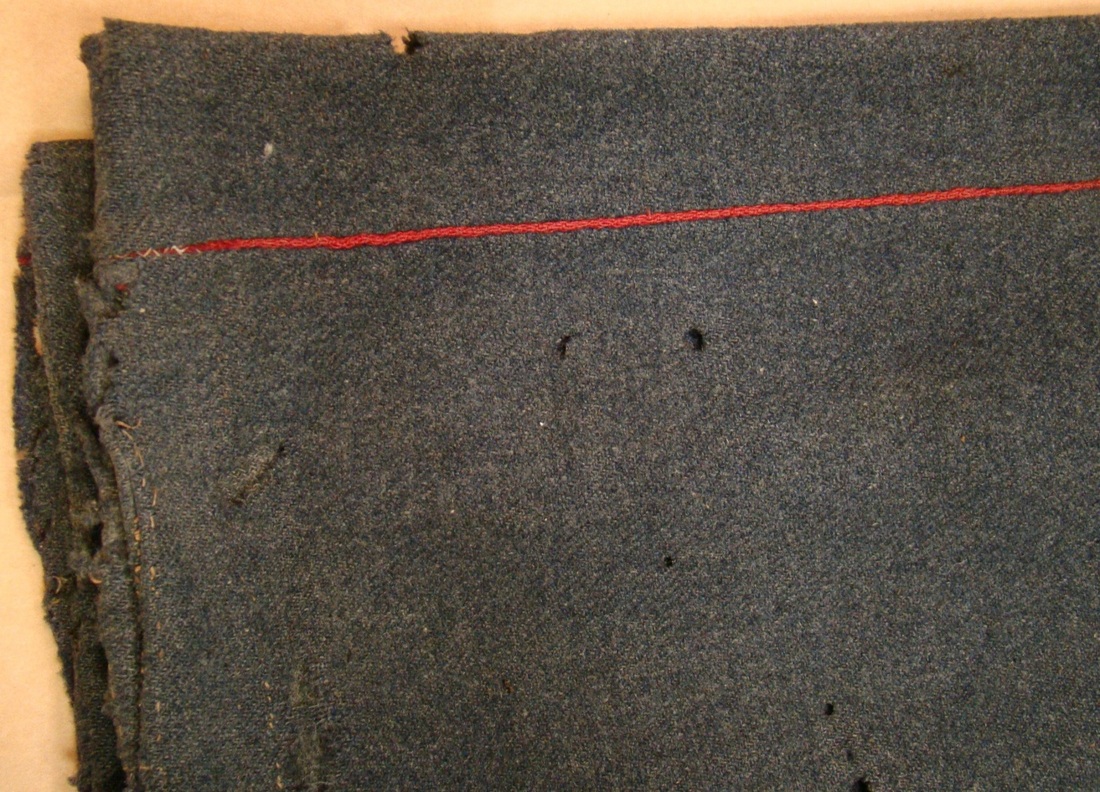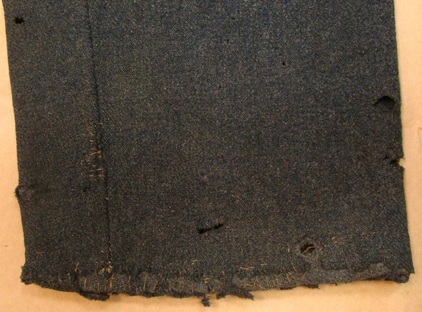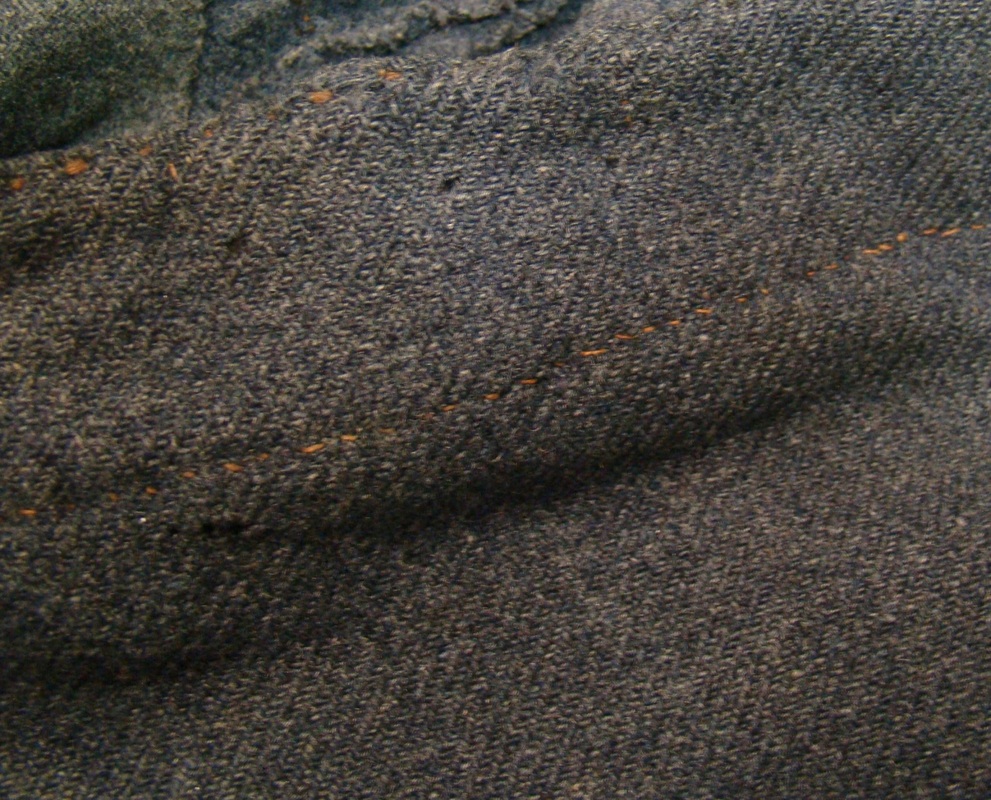Peter
Tait Trousers Finally Surface: Alabama Tait Contract Artillery Trousers
By Fred Adolphus, 24 April 2014
By the end of 2010, I had amassed photos of all the surviving Peter Tait Contract jackets and was well on my way to publishing a book on the topic. I was satisfied with these results, but was continually frustrated by not having found even a single pair of authenticated Tait trousers. I knew from the contract descriptions that they were cadet gray, made from the same material as the jackets, but I could not find an original to pair to confirm any other data. For lack of anything better, I included in my book images of accompanying trousers worn with two Tait jackets, but that were not Tait products themselves. It was not until I was conducting one of my research trips at the Museum of the Confederacy on July 24, 2012 that I finally stumbled across a pair of genuine Peter Tait trousers, and completely by accident at that.
As usual, before making the trip to the museum, I requested a specific number of artifacts for viewing. Included in this list was a pair of pair of tan-colored trousers attributed to Jesse Bryant Beck, Company A, 25th Alabama Infantry. Had my request remained as such, I might not have discovered the Tait trousers until another visit, or perhaps never. This was not the case, however, due to the redoubtable Robert Hancock, Chief of Collections. Robert had taken the initiative to include not only Beck's tan jeans trousers, but an additional pair of cadet gray trousers owned by Beck. When Robert mentioned this, I thanked him for his thoughtfulness, but otherwise dismissed the cadet gray trousers as a matter of secondary importance. It was only when I noticed the red edging down the leg seams of these trousers that their significance dawned on me. My eyes must have bulged from their sockets as the pieces of the puzzle fell together. I knew that Beck had received clothing from the Department of Alabama, Mississippi and East Louisiana after the Tennessee campaign. At the same time, he would have been eligible, as an Alabamian, to have received a Tait uniform from the State of Alabama. The most logical explanation was that these cadet gray trousers were Tait Alabama contract trousers!
I was so excited at this potential discovery, that I began examining Beck's cadet gray trousers ahead of everything else on the table. I looked at the linings and they appeared to be the same as were found in the Harry Pillans, Tait Alabama contract jacket. The construction details and thread were the same, as well. I had finally found a pair of Peter Tait trousers, albeit made from a pre-cut set sent to Alabama.
Jesse Beck, despite being an infantryman, had received a pair of artillery trousers. It was not uncommon for Confederate infantrymen to draw artillery clothing, or vice versa. The trousers are remarkable because the confirm that Tait trousers indeed matched the jackets in color. They also show that at least some of the trousers were trimmed with the branch of service color by adding a welt along the outside leg seams. In this case, the trim is for artillery, but it is safe to assume that infantry trousers were likewise trimmed with royal blue welts. It also indicates that the Alabama contract Tait uniforms were all trimmed, judging from the fully-faced infantry jacket of Harry Pillans and the edged artillery trousers of Jesse Beck.
Jesse Bryant Beck enlisted in Company A, 25th Alabama Infantry on August 29, 1861 in Montgomery, Alabama “for the war.” He was promoted from private to first sergeant on October 1, 1863, and retained this position until his parole at the end of the war. He apparently took part in the Kentucky Campaign of 1862, as he was reported sick in Kentucky that October. In January 1863, he was paid in Atlanta, Georgia. He was reported in the hospital in February 1863, and again on January 19, 1865 at the Way Hospital in Meridian, Mississippi. The Way Hospital listed him as wounded. His last records indicate that he was paroled on June 1, 1865 in Montgomery, Alabama, thus ending his service. His parole describes him as five feet, six inches tall, with dark hair, blue eyes and a light complexion.
Jesse Beck's descendants donated both pairs of his trousers to the Museum of the Confederacy in 1952. They left not only a legacy of Beck's service but provided evidence for how Alabama soldiers were well-provided for in the last months of the war by both the Confederate government and their home state's quartermaster bureau.
It is too bad that I did not find out about these trousers in time to include them in my book on Tait uniforms. Nonetheless, they have come to light now, and they fill in a gap of knowledge that has been missing for many years.
By Fred Adolphus, 24 April 2014
By the end of 2010, I had amassed photos of all the surviving Peter Tait Contract jackets and was well on my way to publishing a book on the topic. I was satisfied with these results, but was continually frustrated by not having found even a single pair of authenticated Tait trousers. I knew from the contract descriptions that they were cadet gray, made from the same material as the jackets, but I could not find an original to pair to confirm any other data. For lack of anything better, I included in my book images of accompanying trousers worn with two Tait jackets, but that were not Tait products themselves. It was not until I was conducting one of my research trips at the Museum of the Confederacy on July 24, 2012 that I finally stumbled across a pair of genuine Peter Tait trousers, and completely by accident at that.
As usual, before making the trip to the museum, I requested a specific number of artifacts for viewing. Included in this list was a pair of pair of tan-colored trousers attributed to Jesse Bryant Beck, Company A, 25th Alabama Infantry. Had my request remained as such, I might not have discovered the Tait trousers until another visit, or perhaps never. This was not the case, however, due to the redoubtable Robert Hancock, Chief of Collections. Robert had taken the initiative to include not only Beck's tan jeans trousers, but an additional pair of cadet gray trousers owned by Beck. When Robert mentioned this, I thanked him for his thoughtfulness, but otherwise dismissed the cadet gray trousers as a matter of secondary importance. It was only when I noticed the red edging down the leg seams of these trousers that their significance dawned on me. My eyes must have bulged from their sockets as the pieces of the puzzle fell together. I knew that Beck had received clothing from the Department of Alabama, Mississippi and East Louisiana after the Tennessee campaign. At the same time, he would have been eligible, as an Alabamian, to have received a Tait uniform from the State of Alabama. The most logical explanation was that these cadet gray trousers were Tait Alabama contract trousers!
I was so excited at this potential discovery, that I began examining Beck's cadet gray trousers ahead of everything else on the table. I looked at the linings and they appeared to be the same as were found in the Harry Pillans, Tait Alabama contract jacket. The construction details and thread were the same, as well. I had finally found a pair of Peter Tait trousers, albeit made from a pre-cut set sent to Alabama.
Jesse Beck, despite being an infantryman, had received a pair of artillery trousers. It was not uncommon for Confederate infantrymen to draw artillery clothing, or vice versa. The trousers are remarkable because the confirm that Tait trousers indeed matched the jackets in color. They also show that at least some of the trousers were trimmed with the branch of service color by adding a welt along the outside leg seams. In this case, the trim is for artillery, but it is safe to assume that infantry trousers were likewise trimmed with royal blue welts. It also indicates that the Alabama contract Tait uniforms were all trimmed, judging from the fully-faced infantry jacket of Harry Pillans and the edged artillery trousers of Jesse Beck.
Jesse Bryant Beck enlisted in Company A, 25th Alabama Infantry on August 29, 1861 in Montgomery, Alabama “for the war.” He was promoted from private to first sergeant on October 1, 1863, and retained this position until his parole at the end of the war. He apparently took part in the Kentucky Campaign of 1862, as he was reported sick in Kentucky that October. In January 1863, he was paid in Atlanta, Georgia. He was reported in the hospital in February 1863, and again on January 19, 1865 at the Way Hospital in Meridian, Mississippi. The Way Hospital listed him as wounded. His last records indicate that he was paroled on June 1, 1865 in Montgomery, Alabama, thus ending his service. His parole describes him as five feet, six inches tall, with dark hair, blue eyes and a light complexion.
Jesse Beck's descendants donated both pairs of his trousers to the Museum of the Confederacy in 1952. They left not only a legacy of Beck's service but provided evidence for how Alabama soldiers were well-provided for in the last months of the war by both the Confederate government and their home state's quartermaster bureau.
It is too bad that I did not find out about these trousers in time to include them in my book on Tait uniforms. Nonetheless, they have come to light now, and they fill in a gap of knowledge that has been missing for many years.
The
author extends his gratitude to the Museum of the Confederacy, and Chief
Curator Robert Hancock for facilitating this study of the Beck trousers. Readers are reminded that all images herein
are the property of Adolphus Confederate Uniforms, are copyrighted, and may not
be reproduced with the author’s permission.
